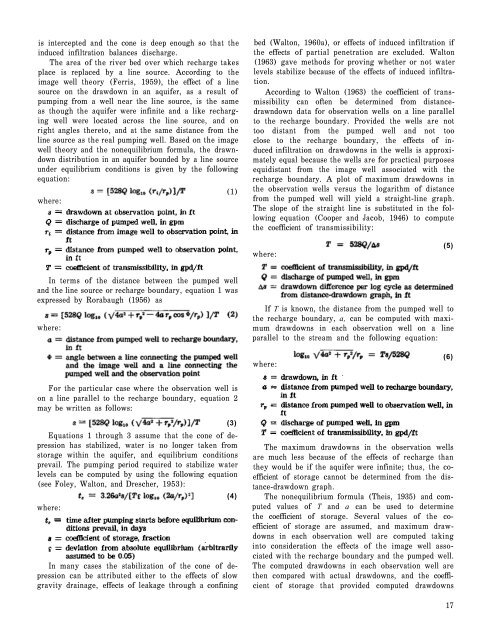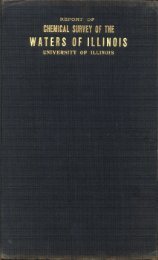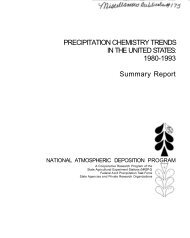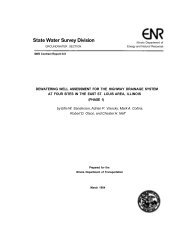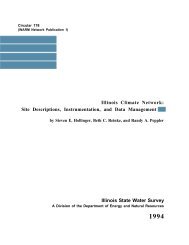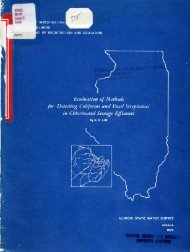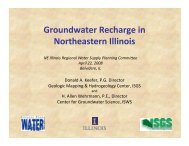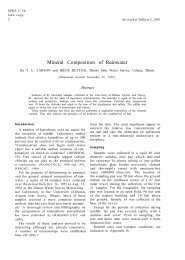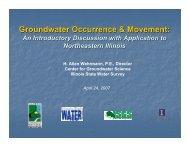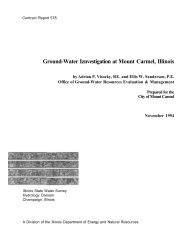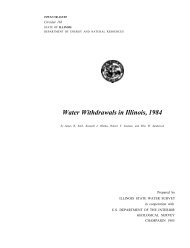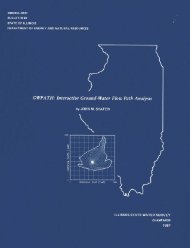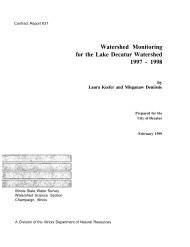Ground-water development in East St. Louis area, Illinois. Urbana, IL ...
Ground-water development in East St. Louis area, Illinois. Urbana, IL ...
Ground-water development in East St. Louis area, Illinois. Urbana, IL ...
You also want an ePaper? Increase the reach of your titles
YUMPU automatically turns print PDFs into web optimized ePapers that Google loves.
is <strong>in</strong>tercepted and the cone is deep enough so that the<br />
<strong>in</strong>duced <strong>in</strong>filtration balances discharge.<br />
The <strong>area</strong> of the river bed over which recharge takes<br />
place is replaced by a l<strong>in</strong>e source. Accord<strong>in</strong>g to the<br />
image well theory (Ferris, 1959), the effect of a l<strong>in</strong>e<br />
source on the drawdown <strong>in</strong> an aquifer, as a result of<br />
pump<strong>in</strong>g from a well near the l<strong>in</strong>e source, is the same<br />
as though the aquifer were <strong>in</strong>f<strong>in</strong>ite and a like recharg<strong>in</strong>g<br />
well were located across the l<strong>in</strong>e source, and on<br />
right angles thereto, and at the same distance from the<br />
l<strong>in</strong>e source as the real pump<strong>in</strong>g well. Based on the image<br />
well theory and the nonequilibrium formula, the drawndown<br />
distribution <strong>in</strong> an aquifer bounded by a l<strong>in</strong>e source<br />
under equilibrium conditions is given by the follow<strong>in</strong>g<br />
equation:<br />
where:<br />
(1)<br />
bed (Walton, 1960a), or effects of <strong>in</strong>duced <strong>in</strong>filtration if<br />
the effects of partial penetration are excluded. Walton<br />
(1963) gave methods for prov<strong>in</strong>g whether or not <strong>water</strong><br />
levels stabilize because of the effects of <strong>in</strong>duced <strong>in</strong>filtration.<br />
Accord<strong>in</strong>g to Walton (1963) the coefficient of transmissibility<br />
can often be determ<strong>in</strong>ed from distancedrawndown<br />
data for observation wells on a l<strong>in</strong>e parallel<br />
to the recharge boundary. Provided the wells are not<br />
too distant from the pumped well and not too<br />
close to the recharge boundary, the effects of <strong>in</strong>duced<br />
<strong>in</strong>filtration on drawdowns <strong>in</strong> the wells is approximately<br />
equal because the wells are for practical purposes<br />
equidistant from the image well associated with the<br />
recharge boundary. A plot of maximum drawdowns <strong>in</strong><br />
the observation wells versus the logarithm of distance<br />
from the pumped well will yield a straight-l<strong>in</strong>e graph.<br />
The slope of the straight l<strong>in</strong>e is substituted <strong>in</strong> the follow<strong>in</strong>g<br />
equation (Cooper and Jacob, 1946) to compute<br />
the coefficient of transmissibility:<br />
where:<br />
(5)<br />
In terms of the distance between the pumped well<br />
and the l<strong>in</strong>e source or recharge boundary, equation 1 was<br />
expressed by Rorabaugh (1956) as<br />
where:<br />
If T is known, the distance from the pumped well to<br />
the recharge boundary, a, can be computed with maximum<br />
drawdowns <strong>in</strong> each observation well on a l<strong>in</strong>e<br />
parallel to the stream and the follow<strong>in</strong>g equation:<br />
where:<br />
(6)<br />
For the particular case where the observation well is<br />
on a l<strong>in</strong>e parallel to the recharge boundary, equation 2<br />
may be written as follows:<br />
Equations 1 through 3 assume that the cone of depression<br />
has stabilized, <strong>water</strong> is no longer taken from<br />
storage with<strong>in</strong> the aquifer, and equilibrium conditions<br />
prevail. The pump<strong>in</strong>g period required to stabilize <strong>water</strong><br />
levels can be computed by us<strong>in</strong>g the follow<strong>in</strong>g equation<br />
(see Foley, Walton, and Drescher, 1953):<br />
where:<br />
In many cases the stabilization of the cone of depression<br />
can be attributed either to the effects of slow<br />
gravity dra<strong>in</strong>age, effects of leakage through a conf<strong>in</strong><strong>in</strong>g<br />
(3)<br />
(4)<br />
The maximum drawdowns <strong>in</strong> the observation wells<br />
are much less because of the effects of recharge than<br />
they would be if the aquifer were <strong>in</strong>f<strong>in</strong>ite; thus, the coefficient<br />
of storage cannot be determ<strong>in</strong>ed from the distance-drawdown<br />
graph.<br />
The nonequilibrium formula (Theis, 1935) and computed<br />
values of T and a can be used to determ<strong>in</strong>e<br />
the coefficient of storage. Several values of the coefficient<br />
of storage are assumed, and maximum drawdowns<br />
<strong>in</strong> each observation well are computed tak<strong>in</strong>g<br />
<strong>in</strong>to consideration the effects of the image well associated<br />
with the recharge boundary and the pumped well.<br />
The computed drawdowns <strong>in</strong> each observation well are<br />
then compared with actual drawdowns, and the coefficient<br />
of storage that provided computed drawdowns<br />
17


